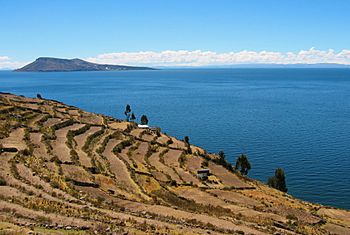Amantaní facts for kids

Amantani in the distance as seen from Taquile
|
|
| Geography | |
|---|---|
| Location | Lake Titicaca |
| Area | 9.28 km2 (3.58 sq mi) |
| Highest point | Pachatata |
| Administration | |
|
Peru
|
|
| Demographics | |
| Population | 3.557 (2017) |
| Ethnic groups | Quechua |
Amantani is a beautiful island located in Lake Titicaca, on the Peruvian side. It's home to a community of about 3,500 Quechua-speaking people. The island is shaped like a circle and covers an area of about 9.28 square kilometers.
Amantani has two special mountain peaks: Pachatata (meaning "father earth") and Pachamama (meaning "mother earth"). At the top of both mountains, you can find ancient ruins from the Inca and Tiwanaku civilizations. The hillsides of the island are shaped into terraces, which are like giant steps. Farmers work these terraces by hand to grow crops such as wheat, quinoa, and potatoes. You can also see animals like sheep grazing on the slopes.
Amantani is often called the "Island of the Kantuta". This is because the kantuta flower, which is the national flower of both Peru and Bolivia, grows everywhere on the island.
Discover Amantani Island
Amantani is a unique place where ancient traditions are still very much alive. The islanders live a simple life, connected to their land and heritage. It's a great place to learn about Peruvian culture and history.
Life on Amantani
The people of Amantani are skilled at making textiles, which are woven fabrics, and beautiful ceramics. Most of the islanders live in houses made of adobe, which is a type of sun-dried mud brick.
The island has a small health clinic and a school for the children. There are no cars on Amantani, so people get around by walking. This helps keep the island peaceful and quiet.
Special Traditions
The temples on top of the Pachatata and Pachamama peaks are usually closed to visitors. However, they open for a special annual feast day, which happens around January 20th. On this day, the island's people divide into two groups, with each group gathering at its mountain's temple.
A race is then held between the two peaks. A runner from each group is chosen to compete. According to the island's traditions, if the runner from Pachamama wins, it means there will be a very good harvest in the coming year. This shows how important their connection to the land is.
Visiting Amantani
There are no big hotels on Amantani. Instead, some local families welcome tourists into their homes for overnight stays. They also provide delicious home-cooked meals. These stays are usually arranged through tour guides.
Families who host tourists must have a special room ready for guests. Visitors often bring gifts for the families, like cooking oil, rice, or fruit. School supplies are also a great gift for the children on the island. It's best to avoid bringing sweets, as regular dental care is not common there.
In the evenings, host families often put on traditional dance shows for their guests. They might even invite you to dress up in their traditional clothes and join in the dancing! Women on the island also make alpaca-wool hats. They offer these hats to visitors to buy, which are perfect for keeping warm in the cool evening breeze.
See also
 In Spanish: Amantaní para niños
In Spanish: Amantaní para niños


